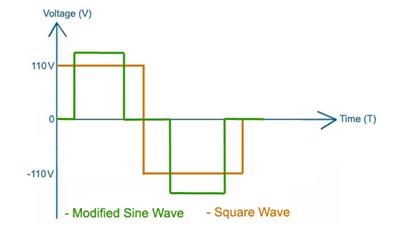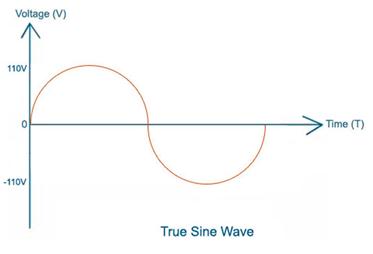The Solar Inverter is an integral part of the entire power system for both Grid Connect and Off Grid solar solutions. The inverters are classified according to their output waveforms with the three common types being the square wave, the sine wave and the modified sine wave.
Square wave :
The square wave is simple and cheaper, however, it has a low power quality compared to the other two. The modified square wave provides a better power quality (THD~ 45%) and is suitable for most electronic equipment. These have rectangular pulses that have dead spots between the positive half cycle and the negative half cycle (THD about 24%).

Figure 2: Modified sine waveform
Sine wave :
A power inverter device that produces a multiple step sinusoidal AC waveform is referred to as a sine wave inverter. To more clearly distinguish the inverters with outputs of much less distortion than the modified sine wave (three-step) inverter designs, the manufacturers often use the phrase pure sine wave inverter.
Where power inverter devices substitute for standard line power, a sine wave output is desirable because many electrical products are engineered to work best with a sine wave AC power source. The standard electric utility provides a sine wave, typically with minor imperfections but sometimes with significant distortion.
The true sine wave inverter has the best waveform with the lowest THD of about 3%. However, It is the most expensive and used in applications such as medical equipment, stereos, laser printers and other applications requiring sinusoidal waveforms. These are also used in the grid ties inverters and grid connected equipment.

Figure 3: Pure Sine wave
Modified sine wave
The modified sine wave is the sum of two square waves, one of which is delayed one-quarter of the period with respect to the other. The result is a waveform which has voltage steps of zero, peak positive, zero, peak negative and again zero. This voltage value sequence is repeated continuously. The resultant voltage waveform better approximates the shape of a sinusoidal voltage waveform than a single square wave. Most inexpensive consumer power inverters produce a modified sine wave rather than a pure sine wave.
If the waveform is chosen to have its peak voltage values for half of the cycle time, the peak voltage to RMS voltage ratio is the same as for a sine wave. The DC bus voltage may be actively regulated, or the "on" and "off" times can be modified to maintain the same RMS value output up to the DC bus voltage to compensate for DC bus voltage variations. By changing the pulse width, the harmonic spectrum can be changed. The lowest THD for a three-step modified sine wave is 30% when the pulses are at 130 degrees width of each electrical cycle. This is slightly lower than for a square wave.
If you have any requirements or any kind of query regarding the EverExceed Inverter solution for your desired applications, feel free to communicate with our dedicated team at any time at marketing@everexceed.com.
Thẻ :
Thể loại
gần đây bài đăng
quét vào wechat:everexceed
